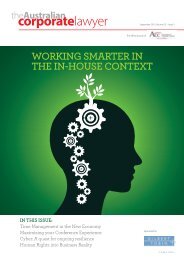Australian Corporate Lawyer - Autumn 2017
Australian Corporate Lawyer is the official publication of the Association of Corporate Counsel (ACC) Australia. The Autumn 2018 issue focuses on 'The Law and Technology' and features a range of articles covering topics including: the future of contracts and; the future of law firms as software companies..
Australian Corporate Lawyer is the official publication of the Association of Corporate Counsel (ACC) Australia. The Autumn 2018 issue focuses on 'The Law and Technology' and features a range of articles covering topics including: the future of contracts and; the future of law firms as software companies..
Create successful ePaper yourself
Turn your PDF publications into a flip-book with our unique Google optimized e-Paper software.
the<strong>Australian</strong>corporatelawyer<br />
DESIGN THINKING – A NEW COMPETITIVE<br />
ADVANTAGE FOR LEGAL TEAMS?<br />
Simon Harper<br />
As co-founder of <strong>Lawyer</strong>s On Demand, Simon<br />
was named ‘Legal Innovator of the Year’ at the<br />
2015 FT Legal Innovative <strong>Lawyer</strong>s Awards for<br />
a decade of “sending shockwaves through the<br />
legal industry”. American <strong>Lawyer</strong> Magazine<br />
named Simon a top 50 innovator of the last<br />
50 years – one of only three UK lawyers to be<br />
recognised as such.<br />
“<br />
Most people make the mistake of<br />
thinking design is what it looks like.<br />
People think it’s this veneer – that<br />
the designers are handed this box and told,<br />
‘Make it look good!’ That’s not what we think<br />
design is. It’s not just what it looks like and feels<br />
like. Design is how it works.”– Steve Jobs<br />
What is design thinking?<br />
Keen observers of the zeitgeist might have<br />
noticed a couple of words recently trending<br />
heavily in the legal world – “design thinking”. If<br />
it’s not already on your radar, then <strong>2017</strong> may<br />
well be the year that corporate legal teams<br />
can’t avoid it. And it’s worth listening – design<br />
thinking can not only help you effectively<br />
identify and solve problems but also shed light<br />
on the wider process of how to work better.<br />
Growing up as the son of a designer<br />
and despite my failure to genetically<br />
pick up the drawing skills, I found<br />
myself accidentally introduced to the<br />
concepts of design thinking as part<br />
of my upbringing. Without being<br />
conscious of the influences, I used that<br />
background when conceiving, building<br />
and growing <strong>Lawyer</strong>s On Demand<br />
(LOD). Over a ten year period, some of<br />
those principles helped us take LOD<br />
from a scribble in a notebook to a 650<br />
lawyer business across eight offices.<br />
As ever, The UK Financial Times was early<br />
to the party during last year’s Innovative<br />
<strong>Lawyer</strong>s Summit with a session on applying<br />
design thinking to legal services. Similarly,<br />
LexisNexis have been pushing the topic<br />
with at least three separate pieces and a<br />
couple of seminars on design thinking in the<br />
last 12 months. Deloitte and PwC are both<br />
regular commentators on design thinking<br />
and it’s a well-established topic on the legal<br />
consultancy landscape. So what’s this all about<br />
and how does it help in-house lawyers.<br />
Design thinking has been a mantra in business<br />
schools for more than a decade and that’s<br />
probably a good place to start for a definition.<br />
“It means taking a creative, experimental, and<br />
user-centred approach to how we provide<br />
legal services,” according to Margaret Hagan,<br />
Director of the Legal Design Lab at Stanford<br />
Law School’s Centre on the Legal Profession.<br />
To pull this apart a little more, this means it’s<br />
an approach to solving the problems of clients<br />
(whether internal or external) centred on us as<br />
human beings. It’s about finding solutions that<br />
are genuinely useful rather than just coldly<br />
analytical. It draws upon logic and reasoning<br />
but also imagination and intuition to create a<br />
beneficial outcome.<br />
“Competing is no longer about creating<br />
dominance in scale-intensive industries,<br />
it’s about producing elegant and refined<br />
products and services in imagination-intensive<br />
industries. As a result, business people don’t<br />
just need to understand designers better, they<br />
need to become designers” – Roger Martin,<br />
author of The Design of Business<br />
The elements of design thinking<br />
Design thinking offers a framework to think<br />
differently about the problems we’re trying<br />
to solve and come up with new solutions.<br />
Though this is to some extent a process, it’s a<br />
fluid rather than prescriptive one. I’d pick on<br />
three things to highlight:<br />
1. Framing the problem<br />
Design thinking recognises that we often<br />
fail not because we arrived at the wrong<br />
solution but because we identified the wrong<br />
problem. To avoid this, our solutions need to<br />
be focused on the insights and needs of a<br />
particular client – or a composite version of<br />
multiple clients. This requires empathy to find<br />
the right problem to address. The best creative<br />
solutions come out of the best insights<br />
into human behavior, coming from both<br />
observation and conversation.<br />
A crucial part of this process is to reframe<br />
the problem – generating a change in<br />
perspective. It was Albert Einstein who said, “If<br />
I had an hour to solve a problem and my life<br />
depended on the solution, I would spend the<br />
first fifty-five minutes determining the proper<br />
question to ask, for once I know the proper<br />
question, I could solve the problem in less<br />
than five minutes.”<br />
2. Generating ideas<br />
This is about solving the problem in multiple<br />
ways. Design thinking teaches us that the<br />
start of this is more of an attitude than a<br />
process: in other words, be curious. There’s<br />
something interesting about everything and<br />
endless curiosity is often the key to ultimately<br />
20 VOLUME 27, ISSUE 1 – AUTUMN <strong>2017</strong>

















